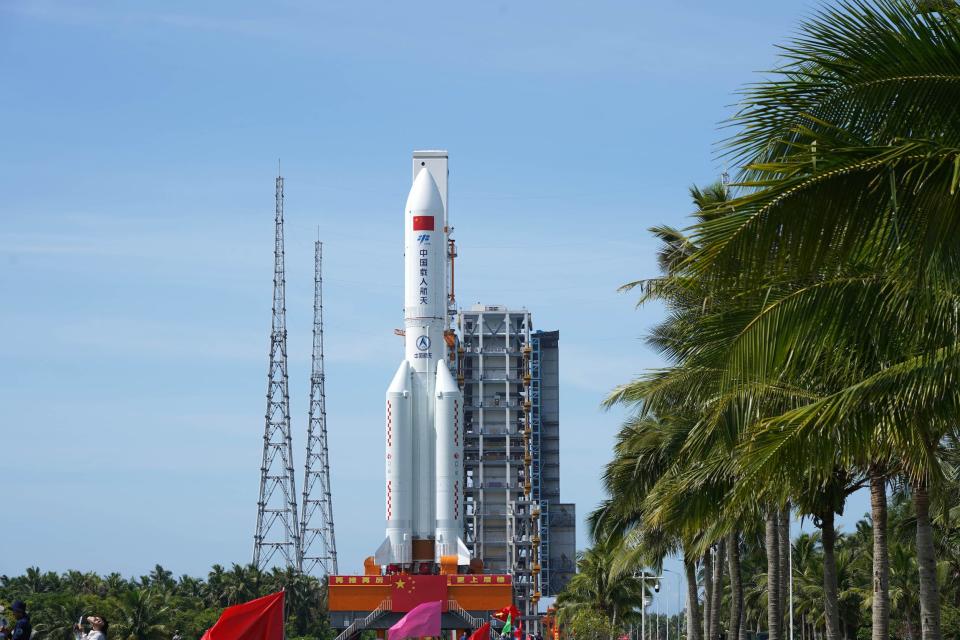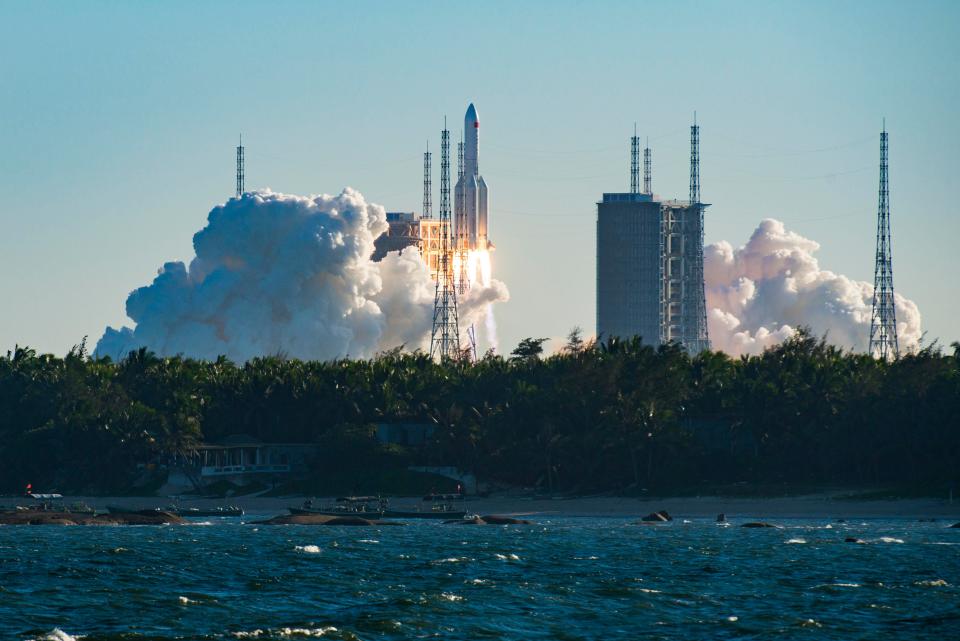Debris from a giant Chinese rocket booster is set to plummet uncontrollably to Earth and rain parts across unknown locations this weekend
Debris from a Chinese rocket is set to fall to Earth sometime this weekend, at an unknown location.
The massive Chinese rocket booster is traveling at 17,000 miles per hour and weighs about 25 tons.
Experts expect between 5 and 9 tons — or up to 18,000 pounds — of material to fall from the sky.
At this moment, a massive Chinese rocket is in the process of crashing to Earth. Experts say the hunk of rocket junk, called the Long March 5B, will probably hit Earth this weekend.
China's rocket launched on July 24 to deliver a lab module to China's Tiangong space station, which is under construction. Researchers at the Aerospace Corporation's Center for Orbital Reentry and Debris Studies, or CORDS, said the rocket junk was descending and would begin an uncontrolled reentry into Earth's atmosphere sometime on Saturday or Sunday.
There is "a non-zero probability of the surviving debris landing in a populated area," CORDS researchers wrote on the center's website.
Using tracking data, researchers created a map that projects a potential field of locations for the space junk's reentry, but the actual reentry point is still uncertain. The blue and yellow lines indicate all the places where the rocket booster could fall.

The yellow satellite icon shows where the booster will be at exactly the middle of the 36-hour window of time when it could possibly fall. (The icon is not a prediction of where the booster will land.)
This is the third time China has launched a Long March 5B and allowed its body to fall to Earth uncontrolled. China is preparing to launch the rocket again in October, Spaceflight Now said.
Predicting the crash landing
At this point, it's impossible to accurately estimate where the rocket stage will fall.
"The snag is that the density of the upper atmosphere varies with time. It's actually weather up there. That makes it impossible to predict exactly at what point the satellite will have plowed through enough atmosphere to melt and break up and finally reenter," Jonathan McDowell, an astrophysicist at the Harvard-Smithsonian Center for Astrophysics, said at a Thursday briefing.
How fast the debris zips through space can lead to huge discrepancies in predictions, McDowell added. If you're an hour off, "because it's going at 17,000 miles an hour, you're 17,000 miles off in where it's going to come down, and that's the big challenge with all this," he said.
Experts at The Aerospace Corporation say the general rule of thumb is that up to 40% of the mass of a large object will reach the ground. In this case, they expect between 5 and 9 tons of material to fall — up to 18,000 pounds.

Normally, after a launch, rockets push themselves into the atmosphere and fall back to Earth over remote ocean areas, such as the South Pacific — a process called "controlled reentry." It's not clear why China hasn't designed or programmed the Long March 5B to do that.
"On the surface, it looks irresponsible. And it's conceivable that they have enough technical data to know that it will come down in the South Pacific, even without being thrust to do that. That's one possibility. But you know, having this big thing fall out of the sky would be nasty," said John Logsdon, the founder of George Washington University's Space Policy Institute and a former member of the NASA Advisory Council.
Rules of behavior in space
If rocket parts land on people or their property, China could be on the hook for the damage. Under the 1972 Space Liability Convention treaty, the launching nation is liable for its rockets and any damage they cause.
Robin Dickey, a space policy analyst at The Aerospace Corporation, said that current debris-mitigation guidelines and long-term sustainability guidelines from the UN's Committee on the Peaceful Uses of Outer Space include recommendations to minimize the risk posed to people and property on Earth from uncontrolled reentries, both of which have been supported by China. "The problem is, is that they're not very technical or specific, and they're also nonbinding. There's no legal consequences to not taking the steps seen as feasible to mitigate the risk," Dickey said at the Thursday briefing.
"One thing I'll be watching closely in response to things like this reentry is who are the actors — the countries, individuals, and companies — that are publicly responding to this behavior and saying that it's irresponsible, because that will indicate whether we'll be able to develop stronger or clearer norms on where the threshold between OK and not OK is," Dickey said.

In May 2021, pieces of another of China's Long March rocket landed in the Indian Ocean. And in May of 2020, another Chinese rocket broke up, dropping debris and causing property damage in Africa.
"They have been participating in the UN discussions on rules of good behavior. And so they're certainly aware of the need for norms of behavior. Whether they're willfully ignoring it in this case — it's hard to think that they would be that irresponsible," Logsdon said.
Read the original article on Business Insider

